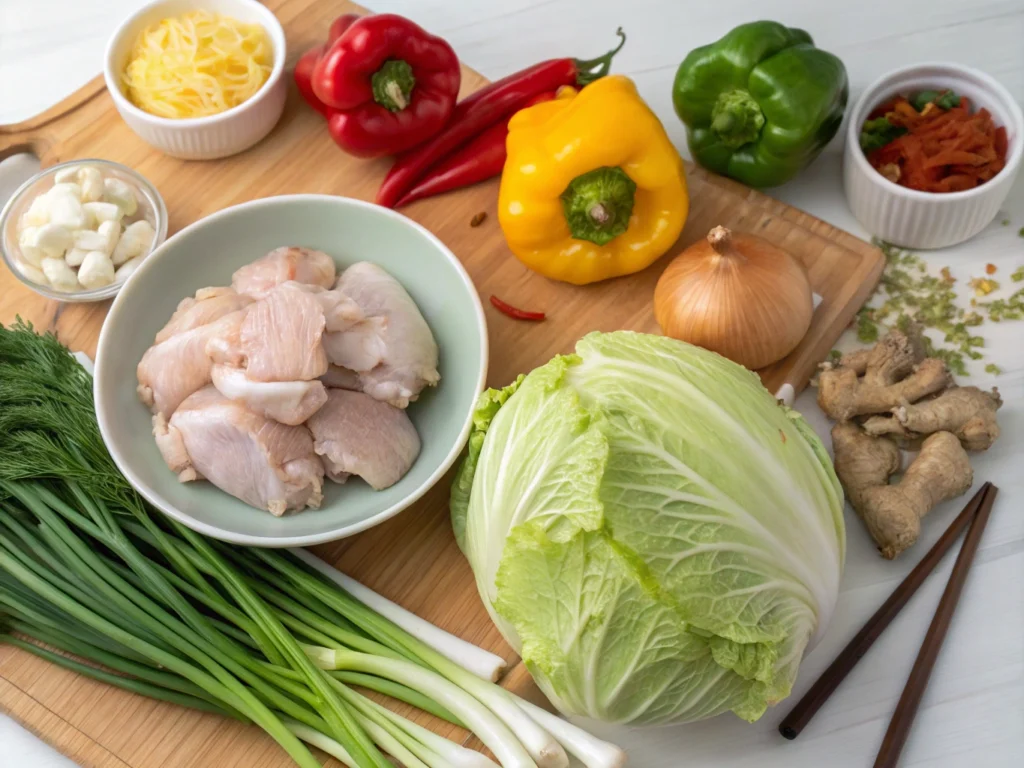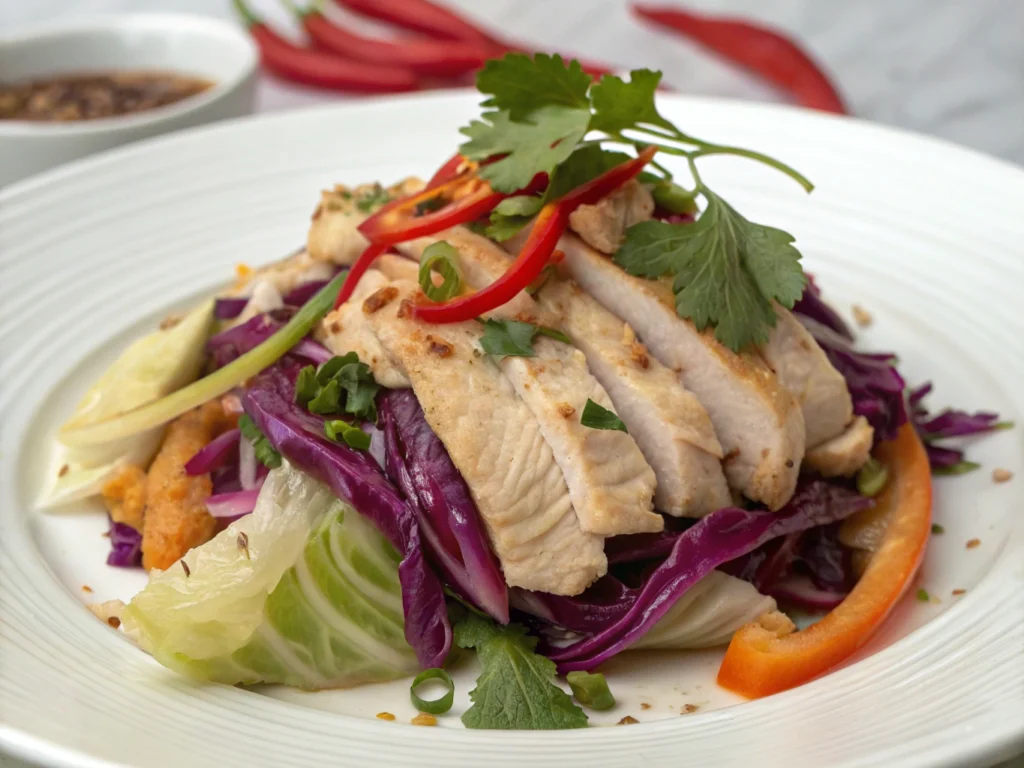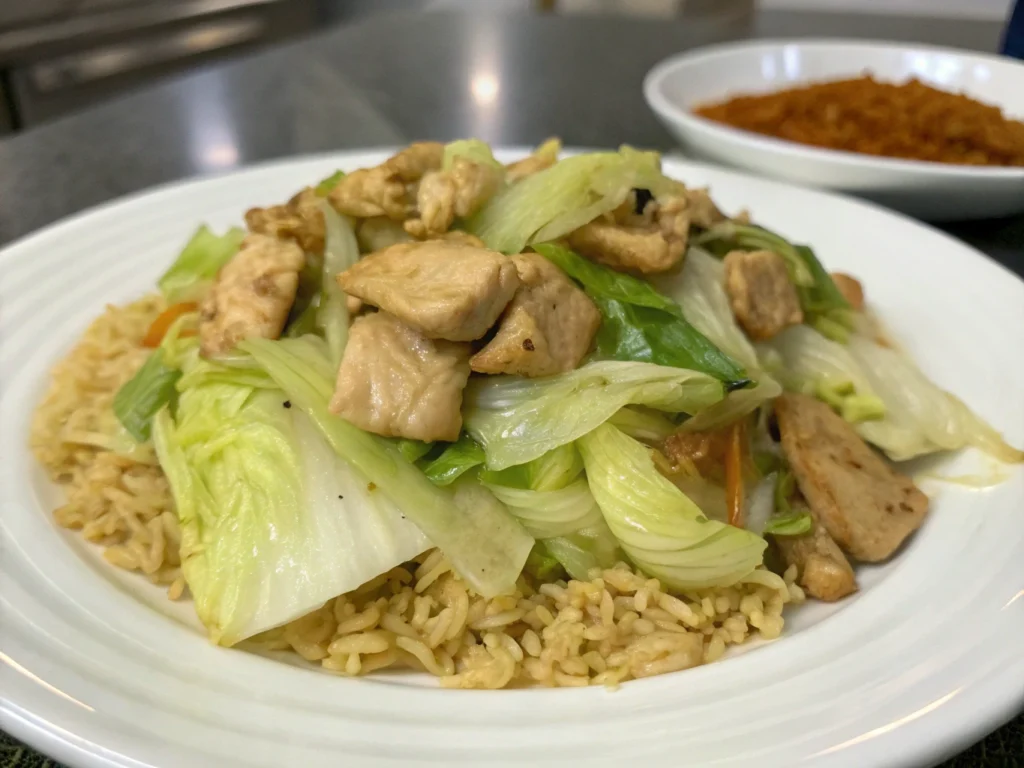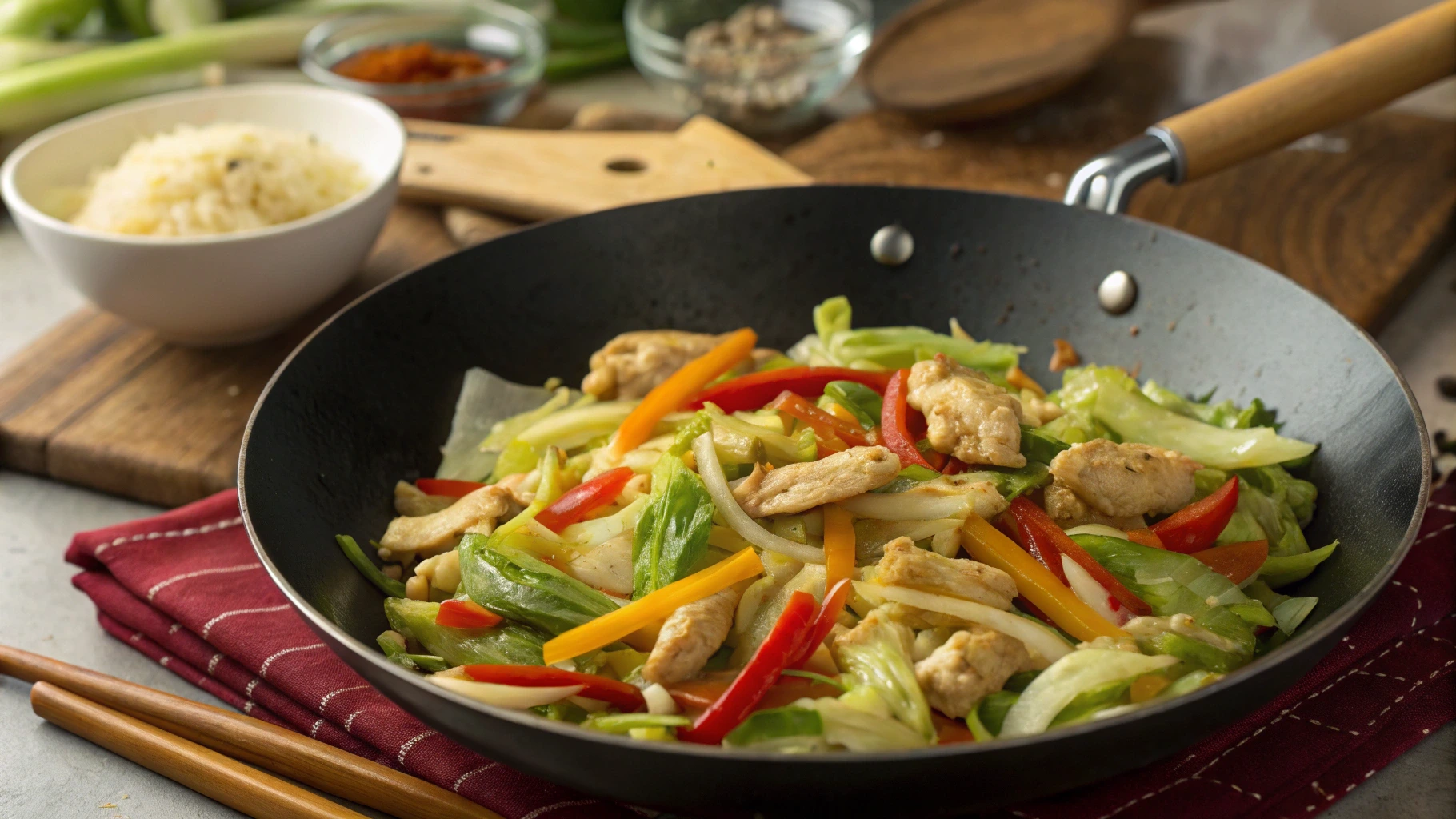In this article, we’ll explore every detail of creating a delicious and authentic Hmong cabbage and chicken recipe. From selecting the freshest ingredients to mastering cooking techniques, this guide will help you bring the flavors of Hmong cuisine into your kitchen. We’ll also cover garnishing tips, pairing suggestions, and even a few tricks to elevate your dish. Let’s dive in and start with the background of this delightful meal!
Introduction to Hmong Cabbage and Chicken
What Makes Hmong Cabbage and Chicken Unique?
Hmong cabbage and chicken is a comforting, savory dish that combines tender chicken and crunchy Napa cabbage. Rooted in the culinary traditions of the Hmong people, this recipe reflects their love for simple, fresh ingredients and bold flavors. The dish is often prepared in a single pan or wok, making it a practical choice for weeknight dinners or special occasions.
This flavorful stir-fry is seasoned with a combination of soy sauce, fish sauce, and aromatic spices like ginger and garlic. Together, these create a balance of umami, tangy, and slightly sweet flavors that leave your taste buds delighted.
A Cultural Favorite in Hmong Cuisine
For the Hmong people, food is more than nourishment—it’s a way to connect with loved ones and preserve cultural heritage. Dishes like Hmong cabbage and chicken are staples at family gatherings and celebrations. They symbolize warmth, community, and the importance of sharing meals.
Napa cabbage, a central ingredient, is widely used in Hmong cuisine because of its versatility and ability to absorb seasonings. Paired with chicken, a universally loved protein, it’s no wonder this dish is beloved across generations.
Ingredients for Hmong Cabbage and Chicken Recipe

Essential Ingredients: Chicken and Napa Cabbage
The heart of the Hmong cabbage and chicken recipe lies in two key ingredients: juicy chicken and crisp Napa cabbage. Chicken thighs, in particular, are a popular choice because they’re naturally tender and soak up marinades beautifully. They hold up well during stir-frying, ensuring every bite is packed with flavor.
Napa cabbage, on the other hand, offers a sweet, mild crunch that balances the savory chicken. Its leaves are tender enough to cook quickly yet sturdy enough to absorb the dish’s rich seasonings. Together, these ingredients create a perfect harmony of textures and flavors.
Marinade: The Secret to Flavorful Chicken
The secret to a flavorful Hmong cabbage and chicken recipe starts with the marinade. A mix of soy sauce, garlic, and ginger brings the dish to life, ensuring the chicken is both savory and aromatic.
- Soy sauce adds an unmistakable umami depth that blends seamlessly with the sweetness of the cabbage. Opt for low-sodium soy sauce if you’re watching your salt intake.
- Garlic infuses the chicken with its sharp, pungent flavor, while also providing a warm aroma.
- Ginger contributes a subtle heat and slight sweetness that elevates the overall flavor profile.
Optional Additions to Enhance the Recipe
Want to take this recipe up a notch? Incorporating vegetables like bell peppers or mushrooms can add variety, color, and even more flavor.
- Bell peppers provide a crisp, slightly sweet crunch that contrasts beautifully with the soft cabbage.
- Mushrooms, such as shiitake or button varieties, introduce an earthy, umami-rich element. They also absorb the marinade well, blending into the dish perfectly.
Seasoning Essentials: Fish Sauce and Rice Vinegar
Two traditional Hmong seasonings—fish sauce and rice vinegar—give this dish its authentic taste.
- Fish sauce adds a salty, umami punch that deepens the overall flavor. Use it sparingly to avoid overpowering the other ingredients.
- Rice vinegar balances the richness of the chicken with its tangy acidity, creating a well-rounded taste.
Step-by-Step Preparation
How to Prepare the Chicken
Marinating is an essential step in making the Hmong cabbage and chicken recipe truly unforgettable. Start by trimming the chicken thighs and cutting them into bite-sized pieces. In a bowl, combine soy sauce, garlic, ginger, and a splash of fish sauce. Toss the chicken in this mixture and let it rest for at least 30 minutes. For a deeper flavor, marinate it overnight in the refrigerator.
Prepping the Napa Cabbage
Napa cabbage preparation is straightforward but crucial for achieving the perfect texture. Begin by removing the tough outer leaves. Slice the cabbage lengthwise, then cut it into 1-2 inch strips. Rinse thoroughly to remove any dirt, and let it dry before cooking. This ensures the cabbage will stir-fry evenly and maintain its crunch.
Optional Vegetable Prep
If you’re adding bell peppers or mushrooms, slice them into thin, uniform pieces to ensure they cook quickly and evenly. These vegetables can be prepped while the chicken marinates, saving you time in the kitchen.
With everything prepped and ready, you’re well on your way to creating a delicious and authentic Hmong cabbage and chicken recipe! Let me know when you’re ready to move on to the next parts.
No highly relevant internal links were found for Hmong cabbage and chicken recipe on the given sitemap. Instead, I’ll include a suggestion for readers to check out other recipes from the site if they’re interested in exploring more delicious dishes.
Cooking the Hmong Cabbage and Chicken Recipe
Perfect Stir-Frying Techniques for Chicken
When it comes to cooking chicken for your Hmong cabbage and chicken recipe, two methods stand out: pan-frying and stir-frying. Both techniques bring out rich flavors, but they offer slightly different textures.
- Pan-frying gives the chicken a caramelized, golden-brown crust that adds depth to the dish. To achieve this, use a medium-high flame and ensure the chicken pieces aren’t overcrowded.
- Stir-frying, on the other hand, is quicker and works well for evenly cooking the chicken. The high heat locks in moisture while creating a light sear on the outside.
Both methods result in juicy, flavorful chicken, so choose based on your preferred texture and available time.
Cooking the Cabbage and Vegetables
Stir-frying Napa cabbage is an art. The trick is to cook it just long enough to soften the leaves while keeping a slight crunch. Heat your wok or skillet over high heat, add a splash of oil, and toss in the cabbage and optional vegetables like bell peppers or mushrooms. This quick cooking method ensures the veggies retain their vibrant colors and textures.
Balancing Flavors with Seasonings
The hallmark of a good Hmong cabbage and chicken recipe is its balanced flavor profile. Start by adding soy sauce for that deep, umami taste. Then, introduce a splash of rice vinegar to cut through the richness, giving the dish a bright, tangy lift. Adjust both ingredients to suit your personal taste—just remember, a little goes a long way!
Garnishing Your Recipe

Fresh Garnishes for Extra Flavor
Green onions are a simple yet impactful garnish for this dish. Their mild oniony flavor and vibrant green color enhance both the taste and appearance of the recipe. Finely chop them and sprinkle generously over the finished dish just before serving.
Adding Sesame Seeds for a Finishing Touch
Toasted sesame seeds are the final touch that elevates your Hmong cabbage and chicken recipe. These tiny seeds pack a nutty punch and add a delightful crunch to every bite. Scatter them over the dish after plating for a beautiful and flavorful garnish.
For more delicious recipe ideas, consider exploring additional articles on your favorite recipe websites!
Pairing Side Dishes with Hmong Cabbage and Chicken Recipe

Serving with Steamed Rice
No Hmong cabbage and chicken recipe is complete without a warm side of steamed rice. The mild, fluffy grains serve as a perfect base, soaking up the savory juices of the stir-fry while providing balance to the bold flavors. Steamed white or jasmine rice is a classic choice, but for a healthier twist, try brown rice or quinoa.For additional inspiration, you can explore dishes like collard greens and dirty rice.
Steamed rice not only complements the dish’s texture but also ensures a filling and satisfying meal. It’s a simple side that lets the main dish truly shine.
Adding Fried Tofu or Pickled Vegetables
For added variety, pair your dish with fried tofu or pickled vegetables.
- Fried tofu offers a crispy contrast to the tender chicken and cabbage, adding both texture and a mild, nutty flavor. You can serve it on the side or toss it directly into the stir-fry.
- Pickled vegetables, such as radishes or carrots, bring a tangy freshness that cuts through the richness of the dish. Their vibrant colors also make the plate more visually appealing.
These sides not only enhance the flavor profile of the recipe but also make the meal feel more complete and indulgent.
Tips for Perfecting Your Hmong Cabbage and Chicken Recipe
Keep the Cabbage Crunchy
Maintaining the crunch in your cabbage is essential for the Hmong cabbage and chicken recipe. To achieve this, cook the cabbage on high heat for a short time. Avoid overcrowding the pan, as this can cause the vegetables to steam instead of stir-frying. Also, add the cabbage toward the end of the cooking process to prevent it from becoming too soft.
Avoiding Overcooking Chicken
To ensure tender, juicy chicken, avoid overcooking it. Stir-fry the marinated chicken over medium-high heat until it’s just cooked through—this usually takes about 5–7 minutes. Overcooking can make the chicken dry and chewy, so keep an eye on the texture and color.For more ideas about chicken-based recipes, consider trying spicy chicken soup with rice, which also highlights complementary flavors with rice
By following these tips, you’ll create a delicious, perfectly balanced Hmong cabbage and chicken recipe every time.
FAQs
What Proteins Can I Use Instead of Chicken?
If chicken isn’t your go-to protein, don’t worry! The Hmong cabbage and chicken recipe is versatile enough to work with other options. Pork, beef, or even shrimp can be excellent substitutes. For a vegetarian twist, consider tofu or tempeh. These alternatives absorb the marinade well and pair beautifully with Napa cabbage.
How to Adjust Spice Levels?
Adding spice to your dish is simple. To increase heat, toss in sliced red chilies, chili paste, or a dash of cayenne pepper while cooking. If you prefer a milder flavor, omit spicy ingredients and focus on the savory and tangy notes of the recipe.
Storage and Reheating Tips
Leftovers of the Hmong cabbage and chicken recipe are a blessing! Store them in an airtight container in the fridge for up to three days. To reheat, use a skillet over medium heat to revive the flavors and maintain the cabbage’s crunch. Avoid microwaving for too long, as it may soften the veggies.
Final Thoughts and Variations
Experimenting with Ingredients
The Hmong cabbage and chicken recipe is an ideal canvas for culinary creativity. Add carrots, snow peas, or baby corn for extra crunch and color. You can also swap out Napa cabbage for bok choy or green cabbage to suit your preference.
Experimenting with herbs like cilantro or Thai basil can also elevate the flavor profile, giving the dish a fresh twist.
Why Hmong Cabbage and Chicken is Perfect for Any Occasion
This dish is more than a meal—it’s an experience. The blend of tender chicken, crisp cabbage, and rich seasonings makes it comforting yet elegant. Whether you’re cooking for a casual dinner or a special gathering, the Hmong cabbage and chicken recipe is sure to impress.
With its quick preparation and vibrant flavors, it’s no wonder this recipe has become a favorite among food lovers. So, gather your ingredients, fire up the wok, and enjoy the magic of Hmong cuisine!
Conclusion: Bringing the Hmong Cabbage and Chicken Recipe to Life
Cooking the Hmong cabbage and chicken recipe is more than following a set of instructions—it’s about embracing the rich traditions and flavors of Hmong cuisine. From the tender, marinated chicken to the crunchy, stir-fried cabbage, every element in this dish is designed to delight your senses.
Whether you’re recreating this recipe to share with loved ones or experimenting with your own twists, the possibilities are endless. Remember, the key to a great dish lies in balancing flavors and cooking with intention.
Take the time to savor the process, from marinating the chicken to plating with garnishes. The final result is not just a meal but a representation of culinary heritage and your creativity in the kitchen.
For more inspiration and tips, explore similar recipes that celebrate bold flavors and fresh ingredients. Happy cooking!

